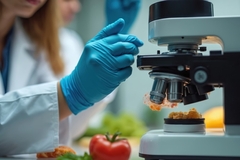
- Industry news
Industry news
- Category news
Category news
- Reports
- Key trends
- Multimedia
- Journal
- Events
- Suppliers
- Home
- Industry news
Industry news
- Category news
Category news
- Reports
- Key trends
- Multimedia
- Events
- Suppliers
GEA talks alternative protein advancements amid rising consumer interest in novel foods
20 May 2024 --- The F&B industry is increasingly shifting focus toward protein produced from diverse sources in a bid to reduce reliance on animal proteins and ensure future food security. Food Ingredients First catches up with Arpad Csay, senior director of New Food North America at GEA, to explore how the company is enabling food tech businesses and start-ups to formulate animal-free proteins amid rising consumer demands for alternative protein products.
Alternative protein use in F&B has grown by 6% from July 2018 to June 2023, indicates Innova Market Insights data. While the bakery segment dominated product launches, meat substitutes witnessed the fastest growth during the period.

GEA aims to propel future growth and innovation in the meat-free protein sector, with a technology center for alternative proteins in Wisconsin, US, which commenced construction last week. The facility is set to open doors for students, young professionals and scientists next year and will provide food tech firms with a platform to “develop and de-risk their processes to ensure technological and commercial viability.”
What are the latest consumer trends driving innovation in the alternative protein sphere?
Csay: Increasing consumer awareness of environmental and ethical issues associated with traditional animal farming is driving innovation in alternative proteins. The trends include rising demand for plant-based and novel food products, driven by flexitarians who occasionally look to replace meat with alternative protein sources. Consumer interest in sustainability, along with demand for improved taste and nutritional profile, are also significant drivers.
 Alternative protein innovations are gaining ground worldwide amid growing consumer concerns for health and the environment.What inspired GEA to focus on alternative proteins in the US?
Alternative protein innovations are gaining ground worldwide amid growing consumer concerns for health and the environment.What inspired GEA to focus on alternative proteins in the US?
Csay: GEA was inspired to focus on alternative proteins in the US due to growing consumer interest in sustainable and low-impact protein sources, its favorable regulatory environment and the level of investment in the region. Recognizing the potential to lead in an emerging market, GEA aims to provide cutting-edge technology and process solutions to help food tech businesses meet consumer demand.
The GEA Technology Center will host activities like pilot production of microbial, cell-based and plant-based processes. It will serve as a hub for process development, testing and scaling novel food products to commercial levels. Educational and training programs for students and young professionals in food technology will also be conducted in collaboration with local academic institutions.
What are the challenges faced by alternative protein manufacturers that the facility will focus on?
Csay: Manufacturers face challenges scaling processes and reducing production costs, especially for novel food applications. GEA’s Technology Center will address these challenges by offering pilot lines for cell cultivation and precision fermentation, helping start-ups develop processes to make them technologically and commercially viable. GEA’s expertise will aid in improving cell densities, yields and titers and help reduce growth medium costs, all essential elements for achieving favorable unit economics at the commercial scale.
How will the project help GEA attain its sustainability goals?
Csay: GEA’s Technology Center fits in well with the group’s sustainability goals by promoting low-impact food production methods that significantly reduce resource use compared to traditional agriculture. This initiative supports GEA’s aim to become a net-zero operation by 2040 and addresses the global demand for ethical, sustainable and nutritious foods.
GEA’s technology center is expected to strengthen the grassroots economy and enhance the region’s attractiveness for collaborative research (Image credit: GEA).The center will help produce protein-rich foods with reduced environmental footprints by advancing bioprocessing technologies like precision fermentation and cell cultivation. This demonstrates GEA’s commitment to innovative and responsible food production practices. Operating the facility using renewable energy sources, like solar power, further demonstrates GEA’s commitment to sustainability.
What response to the project are you expecting from the F&B industry?
Csay: GEA anticipates a positive reaction from the industry, seeing this project as a pioneering effort that fills a critical gap in the new food ecosystem. The industry is expected to welcome the support in scaling and developing alternative proteins, which will aid in diversifying food production methods and enhancing food security.
What alternative protein advancements can we expect to see in the US in the coming times?
Csay: The future of alternative protein foods and beverages in the US is promising and expected to grow significantly in the long-term. Advancements will likely include improved scalability of production processes, leading to reduced costs and enhancements in product taste, texture and nutritional content. I also expect increased consumer acceptance of these improved products along with a solidified and favorable regulatory landscape, leading to broader commercial availability and adoption of these foods.
By Insha Naureen











